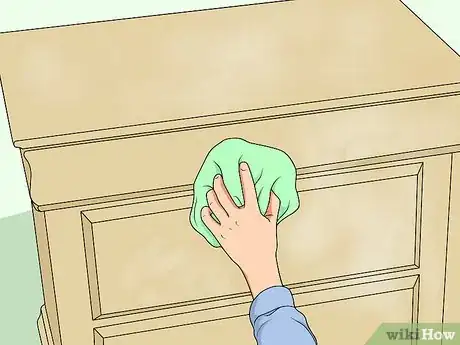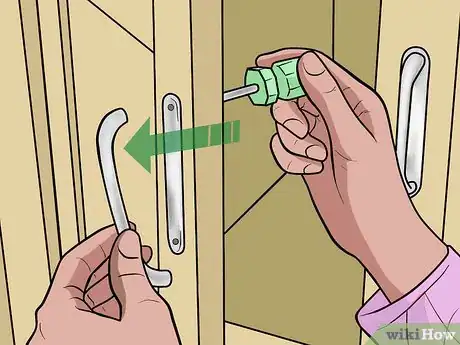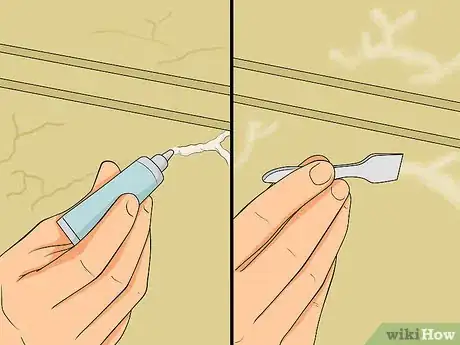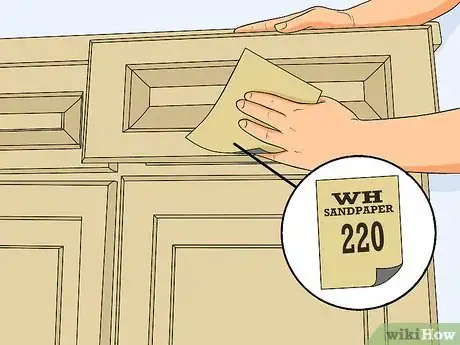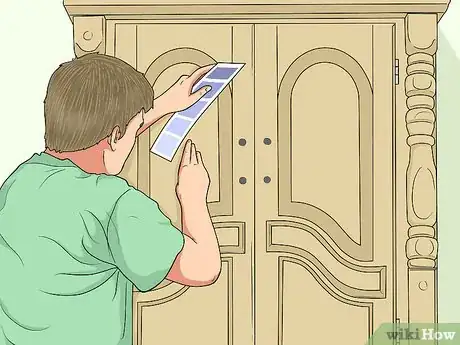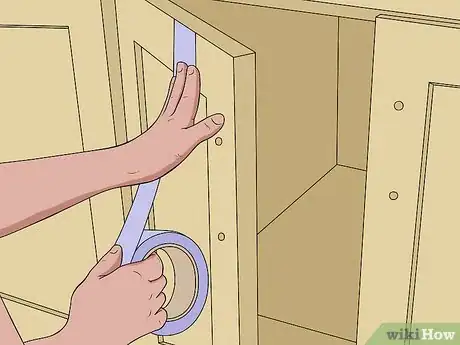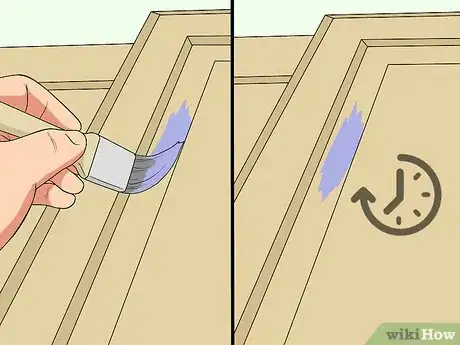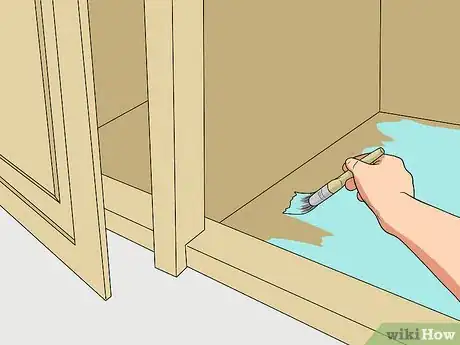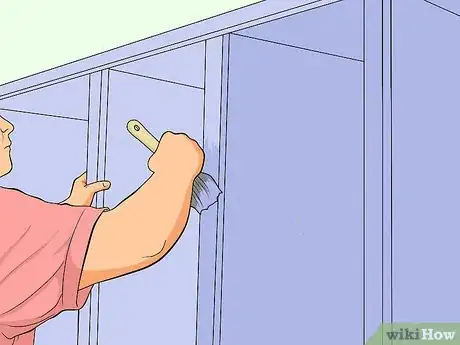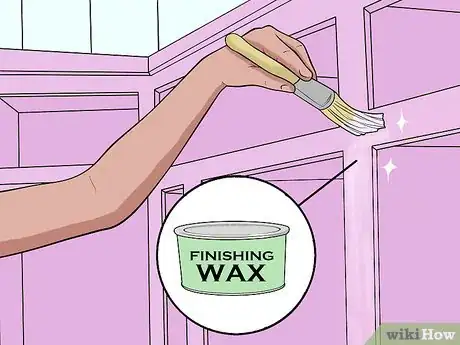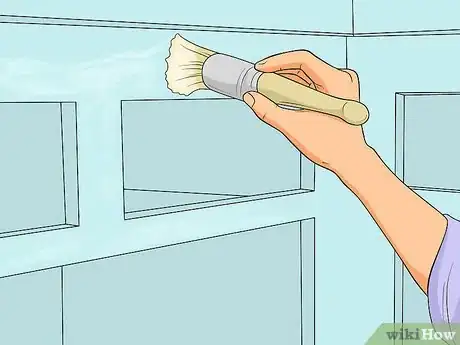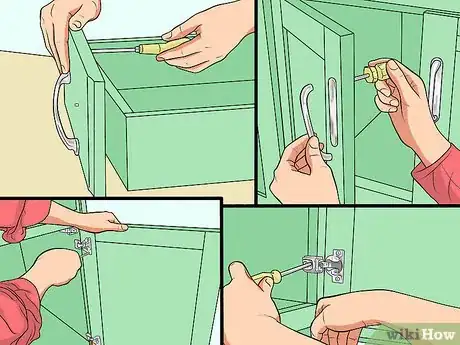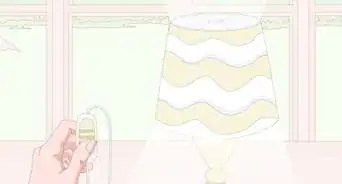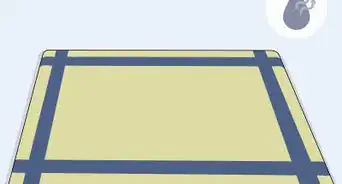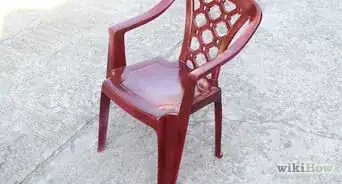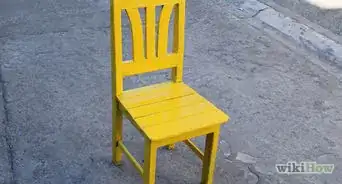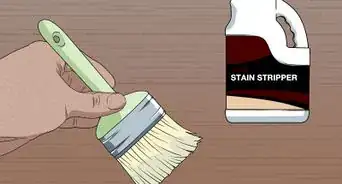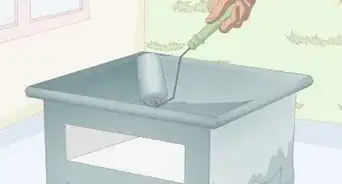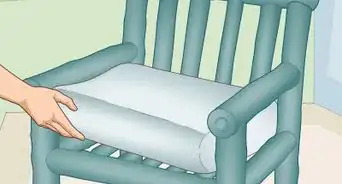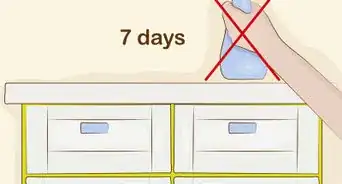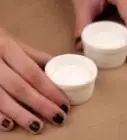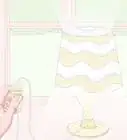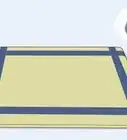This article was co-authored by Tanglewood Sue. Tanglewood Sue is a DIY and Upcycling Specialist and the Owner of Tanglewood Works out of Hyattsville, Maryland. With over nine years of experience, Sue specializes in upcycled painted furniture and other handmade, personalized, and sustainable goods. With her passion for art and reinvention, marketing experience, and Bachelor’s Degree in Broadcast Media, Sue has been able to create a business that not only provides quality pieces but empowers customers to create their works through her library of DIY tutorials and live demos as well as DIY supplies.
There are 7 references cited in this article, which can be found at the bottom of the page.
This article has been viewed 70,606 times.
Chalk paint is great for painting furniture. It comes in every color, and its thickness makes it easy to apply. There’s no need for stripping or priming (which is a huge time saver). All you need is a few coats and a couple of hours to give an old piece of furniture a brand new look.
Things You Should Know
- Prepare the surface of the furniture by cleaning it, removing any hardware, filling in scratches, and sanding it down.
- Mark off areas you want to leave clean with painter’s tape, and apply a test patch of chalk paint before completing a whole coat.
- Paint from the bottom of the furniture to the top, painting with the grain for smoother strokes, and apply 2 or 3 extra coats of paint after the first.
- Complete your project by applying coats of wax before re-installing any hardware.
Steps
Preparing the Surface
-
1Clean off your furniture. Start wiping down your furniture to remove any dirt and debris. Try wiping down the piece with a clean, slightly damp rag first. Then take a cleaning wipe like Lysol or Clorox and go back over it. You don’t want any dust or grit to get stuck under your coats of paint.[1]
-
2Remove any hardware. Before you start painting, be sure to remove any handles, buttons, or decorative items that you don’t want to paint over. As you remove them, pay attention to where they went and how they were installed. This will make it easier when you have to put everything back on. Place each piece into a ziploc bag so they don’t get lost after you start painting.Advertisement
-
3Fill in gouges and deep scratches when needed. If you are painting an older piece or one you purchased from a thrift store, be sure to check it for any marks. Look over the piece first for large discolorations, indents, or scratches. Then run your hands over the item just to be sure. If you find any, use a filler like Elmer’s Wood Filler and a putty knife to close up the gouges.[2]
- You can also leave these marks if you would prefer a more dated and worn look.
-
4Sand down wood furniture. Take a fine-grit sandpaper like Pro Grade Precision 220 and use a sponge or sanding block for consistent pressure. This will keep your sanding even. Work from the top downward. Make sure to sand with the grain as sanding against it can deeply damage the wood.[3]
- Vacuum off and wipe down the furniture again once you’ve finished.
Applying the Paint
-
1Choose a chalk paint color. Chalk paint comes in a variety of colors from white and black to baby blue and light green. You can choose any color you’d like, however, keep in mind that depending on the color of the item you’re painting, you may have to put on additional coats. For example, if you are working with darker colored furniture like a deep mahogany or black metal, you may need to apply three to four coats of a lighter paint.[4]
- However, chalk paint goes on thick and dries quickly, so even multiple coats won’t take long. A four-ounce container should also be more than enough.
- The most popular chalk paint comes from Annie Sloan, but you can also make your own with just latex paint, water, and baking powder.[5]
-
2Mark off areas with painter’s tape. If there are any areas on your furniture that you’d prefer to leave unpainted, make sure to mark them with painter’s tape. For example, if you are working with a dresser or items with drawers, you can add painter’s tape to the side of each to keep them clear. Of course, if you want to paint the entire piece, then painter’s tape is unnecessary.
-
3Test a small patch. Pick a small out of the way area on your furniture. This can be on the back of the piece, inside a drawer, or an inconspicuous corner. Apply one coat of paint and let it dry. Then add another layer and allow that to dry as well. Check for any bleed through of the color beneath the paint. If you don’t see any, feel free to continue.
-
4Start painting from the bottom to the top. The top of the piece usually requires the most attention and coats. So it’s best to start from the bottom of the piece and work upwards. Just as you did with sanding, make sure to paint with the grain. This will make applying the paint easier. It should also make your strokes smoother.
- Once you get to the top of the piece, make sure to paint side to side without stopping.
- You do not need any primer before putting on chalk paint.[8]
-
5Apply two to three additional coats. After you apply the first coat of paint the piece will look rough and unfinished. Don't worry! It is normal for the first coat to look a bit unappealing. Wait for this coat to dry and then apply another immediately after. Each coat should take a half-hour to an hour to dry.[9]
Completing Your Project
-
1Add a coat of wax. After your paint has dried, begin applying your wax. You can use a product like Annie Sloan’s Clear Soft Wax or Minwax Paste Finishing Wax, which will bond to the paint to create a lasting and durable finish. Use a wax brush or soft cloth to apply the wax. Work in small sections and rub the wax into the surface in circular motions.
-
2Apply a final coat of wax. Once you’ve covered the entire piece, wait 10-15 minutes and apply another, final coat. Use a brand new cloth and work in the same manner as before, rubbing the wax into the piece in small sections. Use a separate rag to remove any excess wax as you go along. When you are finished, swipe a finger across the surface to make sure there are no streaks. If you see one, simply run a clean cloth over the area to remove the extra wax.[10]
- It takes wax 21 days to cure completely, so be careful with your furniture until then.
-
3Reinstall your hardware. Once the wax dries, reinstall any hardware you removed before you painted. Be careful of the wax that is still curing when you put each item back on. This is also a good time to clean older hardware or to replace the previous pieces with brand new handles, knobs, or decorative items.
Expert Q&A
-
QuestionHow do I prep furniture for chalk paint?
 Tanglewood SueTanglewood Sue is a DIY and Upcycling Specialist and the Owner of Tanglewood Works out of Hyattsville, Maryland. With over nine years of experience, Sue specializes in upcycled painted furniture and other handmade, personalized, and sustainable goods. With her passion for art and reinvention, marketing experience, and Bachelor’s Degree in Broadcast Media, Sue has been able to create a business that not only provides quality pieces but empowers customers to create their works through her library of DIY tutorials and live demos as well as DIY supplies.
Tanglewood SueTanglewood Sue is a DIY and Upcycling Specialist and the Owner of Tanglewood Works out of Hyattsville, Maryland. With over nine years of experience, Sue specializes in upcycled painted furniture and other handmade, personalized, and sustainable goods. With her passion for art and reinvention, marketing experience, and Bachelor’s Degree in Broadcast Media, Sue has been able to create a business that not only provides quality pieces but empowers customers to create their works through her library of DIY tutorials and live demos as well as DIY supplies.
DIY & Upcycling Specialist Chalk paint doesn't require a lot of prep work at all. All you need to do is lightly sand with a sanding sponge wet with a degreasing agent.
Chalk paint doesn't require a lot of prep work at all. All you need to do is lightly sand with a sanding sponge wet with a degreasing agent. -
QuestionDo I have to sand before using chalk paint?
 Tanglewood SueTanglewood Sue is a DIY and Upcycling Specialist and the Owner of Tanglewood Works out of Hyattsville, Maryland. With over nine years of experience, Sue specializes in upcycled painted furniture and other handmade, personalized, and sustainable goods. With her passion for art and reinvention, marketing experience, and Bachelor’s Degree in Broadcast Media, Sue has been able to create a business that not only provides quality pieces but empowers customers to create their works through her library of DIY tutorials and live demos as well as DIY supplies.
Tanglewood SueTanglewood Sue is a DIY and Upcycling Specialist and the Owner of Tanglewood Works out of Hyattsville, Maryland. With over nine years of experience, Sue specializes in upcycled painted furniture and other handmade, personalized, and sustainable goods. With her passion for art and reinvention, marketing experience, and Bachelor’s Degree in Broadcast Media, Sue has been able to create a business that not only provides quality pieces but empowers customers to create their works through her library of DIY tutorials and live demos as well as DIY supplies.
DIY & Upcycling Specialist You can usually get by without thoroughly sanding the entire piece of furniture.
You can usually get by without thoroughly sanding the entire piece of furniture. -
QuestionI want to use a dark gray or black as the first coat and then a white as the final coat.how do I get the black to show through as a "distressed" piece of furniture?
 Leah C ReitmeierCommunity AnswerI believe you're asking about the "Distressed Look' when Antiquing furniture. What I suggest is that you take a dry rag and dip it in Vaseline or Petroleum Jelly and rub on various areas after painting the furniture. This will take off a bit of the top layer of paint,therefore creating the Distressed Antique Look. You can also "dry brush" the top layer, using just a tiny bit of paint for a slightly different effect.
Leah C ReitmeierCommunity AnswerI believe you're asking about the "Distressed Look' when Antiquing furniture. What I suggest is that you take a dry rag and dip it in Vaseline or Petroleum Jelly and rub on various areas after painting the furniture. This will take off a bit of the top layer of paint,therefore creating the Distressed Antique Look. You can also "dry brush" the top layer, using just a tiny bit of paint for a slightly different effect.
Things You'll Need
- Clean rags or cloths
- Cleaning wipes
- Painter's tape
- Chalk paint
- Soft paintbrush
- Screwdriver
- Wood Filler
- Wax
References
- ↑ http://www.confessionsofaserialdiyer.com/how-to-paint-furniture-using-chalk-paint/
- ↑ http://www.confessionsofaserialdiyer.com/how-to-paint-furniture-using-chalk-paint/
- ↑ http://home.howstuffworks.com/home-improvement/home-diy/furniture-restoration/how-to-refinish-furniture8.htm
- ↑ http://www.dummies.com/home-garden/home-painting/how-to-paint-furniture-with-chalk-paint/
- ↑ http://www.dummies.com/home-garden/home-painting/3-ways-to-create-your-own-chalk-paint/
- ↑ Tanglewood Sue. DIY & Upcycling Specialist. Expert Interview. 24 March 2021
- ↑ http://www.confessionsofaserialdiyer.com/how-to-paint-furniture-using-chalk-paint/
- ↑ Tanglewood Sue. DIY & Upcycling Specialist. Expert Interview. 24 March 2021
- ↑ http://www.thinkingcloset.com/2014/09/22/the-beginners-guide-to-annie-sloan-chalk-paint/
About This Article
Decorating your furniture with chalk paint is convenient and doesn’t require priming or stripping. To prepare your furniture, first remove any handles and other hardware, and wipe the surface with a damp cloth. Then, fill in any cracks with filler, and sand the surfaces down to help the paint stick. If there are any spots you don’t want painted, cover them with masking tape or painter’s tape. Once you've prepared your furniture, apply 2 or 3 coats of your chalk paint with a brush, waiting 30 minutes for each coat to dry. After you’ve achieved the color you want, apply a couple of coats of finishing wax to seal the paint, waiting 15 minutes between coats. For more decorating tips, including how to patch test your chalk paint, read on!
